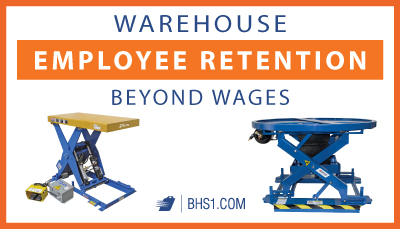We use cookies to make your experience better. To comply with the new e-Privacy directive, we need to ask for your consent to set the cookies. Learn more.
Warehouse Employee Retention Beyond Wages
Warehousing operations often struggle with employee retention. Since August of 2017, separations — quits, terminations, and layoffs — grew by 26,000 jobs in the warehousing industry. During the same period, the quit rate for all industries remained fairly stable, hovering around 2.4 percent.
What is it that drives employees to leave warehousing jobs more than positions in other industries? More to the point, how can employers retain more workers to save on training and hiring costs, while building an experienced workforce that can match ever-increasing productivity goals?

The simple answer would be increased wages. The real picture of warehouse employment is more complicated than any single bottom line, though. A 2007 study in the International Journal of Physical Distribution and Logistics Management suggests that, contrary to most managers’ expectations, pay and benefits are not the main cause of staff turnover in warehouses. Rather, job security and company culture seem to be stronger drivers of retention.
Add the fact that many logistics providers are already operating on razor-thin margins, precluding frequent pay raises, and the demand for a more attractive workplace becomes paramount. Here are a few ways employers in the warehousing industry can retain the skilled workers they need to compete in an era of increasing e-commerce:
-
Create a family-friendly workplace environment.
Researchers found compelling evidence that warehouses with a “family-friendly” environment enjoy significantly fewer quits than buttoned-down, no-nonsense establishments. Offer generous parental leave for employees, and consider next-level benefits like on-site child care. Invite employees and their families to group social events organized around the workday.
-
Invest in ergonomics programs to make work more comfortable.
Discomfort and injury will drive away workers every time. Provide ergonomic advantages, such as variable-height workstations for packing, Pallet Carousel & Skid Positioners for palletizing, and equipment for handling forklift batteries.
-
No matter how big your operation is, manage it like a small, family-owned warehouse.
Larger warehousing operations have higher turnover all around. Researchers theorize that this is because of a lack of strong working relationships between colleagues and management. Smaller, congenial workplaces drive attachment and loyalty — so even if you’re operating a huge business, take the time to interact directly with employees, and create opportunities for coworkers to get to know and enjoy each other.
-
Do whatever it takes to ensure job security for all employees.
A sense of job security may be the most powerful force keeping workers in their positions at a warehouse. The industry is known for temporary, part-time hires — and that leaves employees uneasy and cut off from potential loyalty to the organization. Prioritize job security for the workforce, and be sure staff knows management offers stable careers, not just another gig.
A 2017 survey of warehouse operators found double-digit turnover rates in the majority of respondents. Nearly a third of employers reported turnover rates between 25 and 100 percent. More than 70 percent of the respondents said it takes more than a month for new hires to reach peak productivity, proving that turnover is directly related to the success or failure of a warehousing business.
Whether pay raises and better benefits are in the budget or not, changes in the institutional culture can lead to increased employee retention and ensure that employees remained positive, engaged, and highly productive throughout their careers.
References:
Banker, Steve. “The Best Tactics for Retaining Warehouse Workers.” LogisticsViewpoints. ARC Advisory Group, 30 Oct. 2017. Web. 29 Oct. 2018.
“Job Openings and Labor Turnover Survey News Release.” BLS. Bureau of Labor Statistics, U.S. Department of Labor, 16 Oct. 2018. Web. 29 Oct. 2018.
Min, Hokey. “Examining Sources of Warehouse Employee Turnover.” Proquest. International Journal of Physical Distribution & Logistics Management; Bradford, 2007. Reference Database. 29 Oct. 2018.
